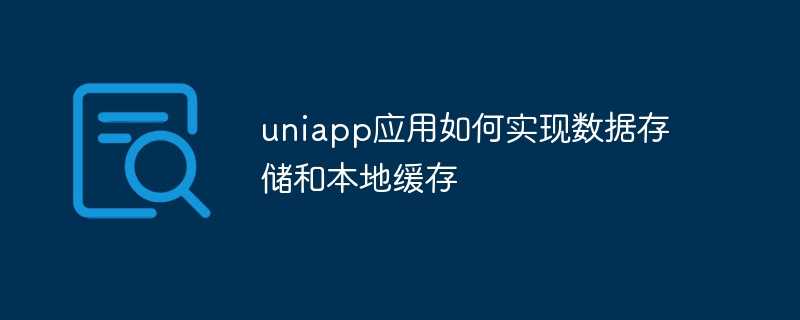
Uniapp是一款跨平台开发框架,可以用于开发微信小程序、H5网页以及其他移动端应用。在开发过程中,数据存储和本地缓存是非常重要的功能。本文将介绍如何在Uniapp中实现数据存储和本地缓存,并提供具体的代码示例。
一、数据存储
Uniapp中实现数据存储的方式有很多种,下面将介绍几种常用的方法。
在Vue中,我们可以使用data属性来存储数据。在Uniapp中,也可以通过这种方式来实现数据存储。例如:
<template>
<view>
<button @click="changeData">改变数据</button>
<view>{{ myData }}</view>
</view>
</template>
<script>
export default {
data() {
return {
myData: 'Hello Uniapp',
}
},
methods: {
changeData() {
this.myData = 'New Data'
},
},
}
</script>Vuex是Vue的状态管理工具,也可以在Uniapp中使用。通过Vuex,我们可以将数据存储在全局的store中,方便在不同的组件中进行访问和修改。例如:
// store.js
import Vue from 'vue'
import Vuex from 'vuex'
Vue.use(Vuex)
const store = new Vuex.Store({
state: {
myData: 'Hello Uniapp',
},
mutations: {
changeData(state, payload) {
state.myData = payload
},
},
})
export default store// main.js
import Vue from 'vue'
import App from './App'
import store from './store'
Vue.config.productionTip = false
App.mpType = 'app'
const app = new Vue({
store,
...App,
})
app.$mount()// MyComponent.vue
<template>
<view>
<button @click="changeData">改变数据</button>
<view>{{ myData }}</view>
</view>
</template>
<script>
export default {
computed: {
myData() {
return this.$store.state.myData
},
},
methods: {
changeData() {
this.$store.commit('changeData', 'New Data')
},
},
}
</script>二、本地缓存
在Uniapp中实现本地缓存可以使用uni-app的api来操作本地存储。常用的api有uni.setStorageSync、uni.getStorageSync、uni.removeStorageSync等。下面是一个具体的示例:
// 存储数据
uni.setStorageSync('myData', 'Hello Uniapp')
// 获取数据
const data = uni.getStorageSync('myData')
console.log(data) // 输出 Hello Uniapp
// 移除数据
uni.removeStorageSync('myData')除了同步的api外,Uniapp还提供了异步的api,例如uni.setStorage、uni.getStorage等。使用异步api可以提高用户界面的响应速度。下面是一个异步api的示例:
// 存储数据
uni.setStorage({
key: 'myData',
data: 'Hello Uniapp',
success: function () {
console.log('数据存储成功')
},
})
// 获取数据
uni.getStorage({
key: 'myData',
success: function (res) {
console.log(res.data) // 输出 Hello Uniapp
},
})
// 移除数据
uni.removeStorage({
key: 'myData',
success: function () {
console.log('数据移除成功')
},
})本文介绍了在Uniapp中实现数据存储和本地缓存的方法,并提供了具体的代码示例。开发者可以根据实际需求,选择适合自己的方式来实现数据存储和本地缓存,提高应用的性能和用户体验。
以上就是uniapp应用如何实现数据存储和本地缓存的详细内容,更多请关注php中文网其它相关文章!

每个人都需要一台速度更快、更稳定的 PC。随着时间的推移,垃圾文件、旧注册表数据和不必要的后台进程会占用资源并降低性能。幸运的是,许多工具可以让 Windows 保持平稳运行。

Copyright 2014-2025 https://www.php.cn/ All Rights Reserved | php.cn | 湘ICP备2023035733号